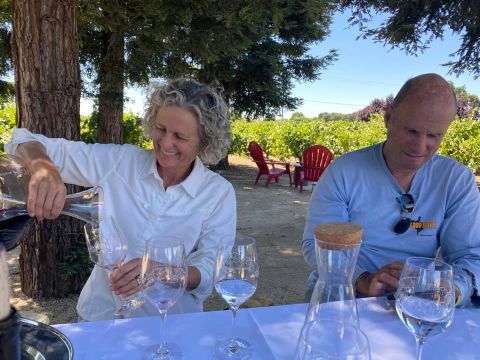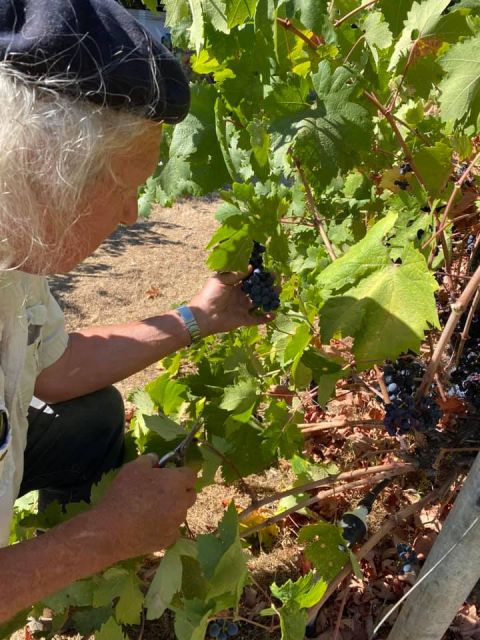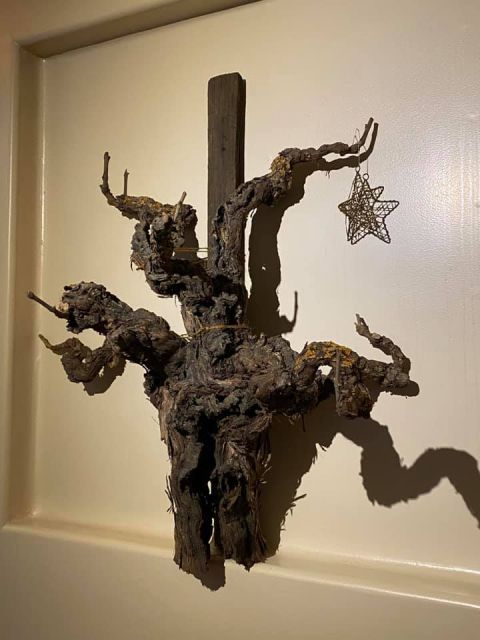'A member of the US Wine Tasting Team, Gwendolyn Alley traveled to the Loire in 2019 to compete in the world blind wine tasting championship. In the 1980s, while selling beans and machines at Peet’s Coffee in Menlo Park, she was lured to pour wine for Ridge when several of the owners asked her to join their team. She left Ridge to hike from Mexico to Canada on the Pacific Crest Trail and double major in Environmental Studies and Literature/Creative Writing at UC Santa Cruz. In the 1990s, she had a newspaper column in the Ojai/Ventura area called Art Predator which led in 2007 to her blog of the same title; in 2008, she began Wine Predator. A freelance content provider who also publishes in print about wine, food, and travel, she’s a Field Coordinator for the 2022 edition of the Slow Wine guide with a focus on the Sierra Foothills, Lodi, and the Central Coast. Gwendolyn lives with her family in Ventura, California where she enjoys helping out in the vineyard and the cellar at Clos des Amis.' See our WWC21 guide for more old-vine competition entries.
Meet Magdalena.
Quite a remarkable, resilient character, according to those who knew her best. Born in the early 1930s, Magdalena lived a long and fruitful life in Lodi, California, luxuriating in the loamy sandy soil, not far from the Mokelumne River until her early death from tractor blight.
Spiro Statos planted Magdalena on her own roots in 1933, a surprising feat following phylloxera, Prohibition, and during the Depression. His Lodi location was ideal for Zinfandel: sandy soils defeat phylloxera that threatened her, close enough to the Pacific that ocean breezes cooled her nights, abundant sun warmed her days, and Sierra Nevada snow and rain quenched her thirst.
Long after she was born, about forty years into her life, surfer and winemaker David Lucas purchased the rundown vineyard where she lived. When he met her, she introduced herself as Magdalena, and immediately David Lucas was smitten.
Magdalena and her organic head-trained Zinfandel sisters and brothers thrive on Lucas’s eighteen acres under vine on the west side of what’s now the Mokelumne River AVA (American Viticultural Area). The 3.5 Zinstar acres are farmed in accordance with CCOF (California Certified Organic Farmers). Old vines like these ripen at lower sugars than other Zinfandel vineyards, resulting in lower alcohol. This gives the wine a more Burgundian character with notes of raspberry, blueberry, and spice. The Lucas wines spend a year or so in French oak, then hang out together for a few more years before heading out into the world.
I’d been talking about growing grapes sustainably and tasting wine with David Lucas and Heather Pyle Lucas when I said I wanted to hear more about their passion for old vines. On a warm summer afternoon, we sat beside the vineyards under the shade of their redwoods which David planted years ago in the hope that they might protect the crush pad from the winds. It had been an animated chat, but their enthusiasm for their old vines livened the conversation up even more.
“It’s all romance,” said David, a romance that is natural and real. The vines need constant care and attention all year long, and require an intimacy that may be hard to imagine.
David suspects and says he has the largest number of head pruned Zinfandel vines in Lodi, if not California and possibly the world (which may or may not be true) yet “every one is individual,” chimed in Heather who has worked with these old vines for twenty years. “They’re all different.”
Some of these old vines have “mouse houses” and tunnels where you can see through the thick gnarled trunk. Richly textured, colorful lichen freckle the sun bleached bark.
“There’s just something about them,” said Heather enthusiastically. “There’s just something more natural about head trained vines. David spends all season going up and down the rows chainsawing weak arms.”
According to David and Heather, working with the old vines is a constant journey together, one that all farming should be, a relationship that’s vigilant, caring between the farmer and the farmed.
Looking carefully at the vines, “you can see eighty years of pruning cuts,” said David. You see one cut, and then the cut before that one, and the one before that, going way back in time. A time machine both for the vine and for the pruner.
“It’s like the rings of a tree,” agreed Heather. The head trained vines look similar to bonsai, and David and Heather take that approach to pruning the vines, as if they are small trees reaching for the stars.
“The light exposes the three dimensional nature of these vines,” said Heather. They show the careful pruner what to retain and what to take off to create an aesthetic balance, a uniformity of girth; the vines speak to where they want to die back.
Most vines today are on a trellis, tall and narrow, not rounded and branching out wildly in all directions, a modern dancer stretching in graceful angles and arcs.
“You put Zins on wire and the outside of the cluster is darker and deeper over pink, but head trained, you get more even ripening,” explained Heather. It’s a lot of work, work that has to be done by hand, not by machine, and requires a human eye making constant and consistent decisions.
I’ve been interning at a Ventura County winery where we’ve been trying to head train young Cabernet and Grenache vines. They remind me of toddlers learning to walk, ungainly, unbalanced, and difficult to communicate with, though I try with a constant conversation as I prune, asking which arms will take the load, and which should go. It’s literally back-breaking work.
Because of the difficulties growing, pruning, and picking these old head trained vines with their low yields, many abandoned these vineyards, leaving behind their elegant and ethereal grapes which remind us of time and history, of days long past. No longer appreciated for the character their longevity brings, grapes from these old vine beauties might be blended indiscriminately or lost in a Rosé. Worse than abandonment, many vineyards have been uprooted and replaced with trellised vines, or the former vineyard paved over and covered with suburban sprawl.
“Nobody values old vines,” remarked Heather sadly, especially the head trained ones.
David said these vineyards chose him, adding, “The only reason I got it was because it was so run down.” Growing old vine Zin, “you can lose your hair,” he said as he rubbed his balding scalp.
I can imagine, I tell him. I got my start in wine at Ridge Vineyards on Montebello Road in the mid-80s pouring at the outdoor tasting room picnic table and gazing at the graceful arabesques of head trained vines. Many years later, summer 2020 found me picking forty year old Zinfandel from a UC Davis experimental plot in upper Ojai, California where the bees and the yellow jackets competed with us for the fruit. The Block Vineyard came from cuttings from the Hall Vineyard, planted in the 1970s. It was a last minute call, asking if Bruce Freeman of Clos des Amis wanted to pick the fruit and make wine from it.
Most of the vineyard was trellised, the grapes unevenly ripe with raisins and green grapes in the same cluster. Bruce chose to do a carbonic maceration with partial whole clusters. A few months ago I tasted it, and I’m looking forward to the finished product. Hopefully these vines, and the other old vines of the world, are destined to stay put so those of us who appreciate these elders will have the opportunity to taste the wines made from them.
“If you think you have something wonderful, it is important to retain what you have” in the vineyard and in the winery,” said David, “and not let ego get in the way.”
Today Magdalena graces an alcove in the Grand Chai (pronounced shay) where she keeps watch while the red wines rest in the barrel, and where visitors can marvel with gratitude at the gifts that old vines bring.
“No better story is told than by a Zinfandel at the table,” said David. And by Zinfandel, he means one from the old, head trained vines.
The photos are provided by Gwendolyn Alley.





